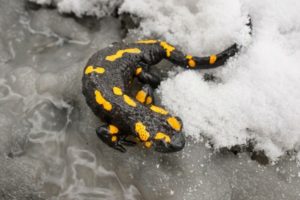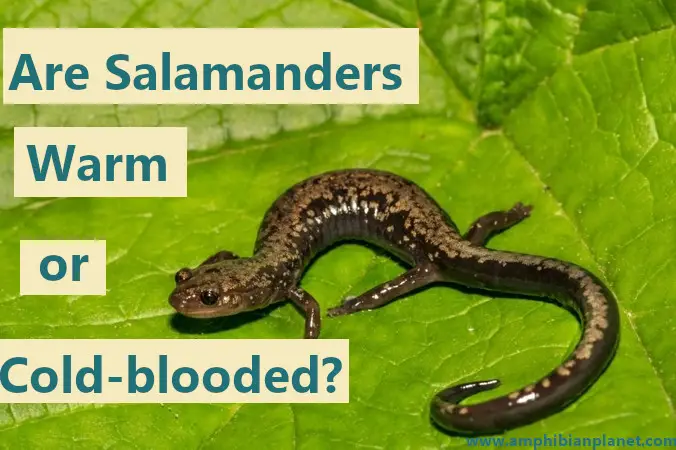In the winter, we don’t see many salamanders or other amphibians around. This is because salamanders cannot internally control their body temperature, so it is at the mercy of the temperatures in their environment.
Salamanders are ectothermic (cold-blooded) animals, which means they cannot regulate their body temperature. Their body temperature changes as the temperature in their surroundings changes.
When it’s warm, their bodies soak up the heat, and their body temperature rises. When it’s cooler, their body temperature falls.
For this reason, most terrestrial Salamanders (salamanders that live on land) spend the majority of their time hiding under rocks, fallen leaves, and logs, to escape the heat of the day. They only emerge from their cover at night or after a rainstorm, when the temperatures are cooler
Salamanders Do Not Have “Cold Blood”
This is in contrast to endothermic (warm-blooded) animals, like humans whose bodies can generate their internal heat through their metabolism.
Being ectothermic means that salamanders will have a reduced metabolism at lower temperatures, and can go long periods without food. However, it also means that they can not move efficiently when the temperatures get too cold.
How Salamanders Regulate Their Body Temperature
Since salamanders can not generate their internal heat, they rely on external heat sources to keep their bodies at optimal temperatures.
When their body temperature is low, they move into the sun to warm up, when it is high, they move to the shade or cool water to cool down. Their skin also secretes more mucous, when it’s hot allowing them to cool through the process of evaporation.
In addition to these behavioral adaptations, salamanders control how much heat they lose or gain by altering the patterns of their blood flow.
When they need to get rid of heat, the blood vessels near their skin get wider through a process known as vasodilation. This increases the quantity of blood flowing to the skin, allowing the extra heat to be lost to their environment.
When the environmental temperatures are low, salamanders need to reduce their heat loss. To do this, the blood vessels near their skin get narrower. This reduces the quantity of blood flowing to the skin and minimizes the heat lost to the environment.
Being “Cold-Blooded” Has Advantages
Being ectothermic gives salamanders many advantages that endothermic (warm-blooded) animals do not have.
- The first advantage is that they require less food to maintain their body temperature – Since salamanders do not generate their body heat, they do not need much energy to regulate their body temperature.
This makes it possible for them to live in harsh environments with little food, that would be off-limits to warm-blooded animals.
- The second advantage is that they can go long periods without food, especially in colder temperatures – In cold temperatures, salamanders have a reduced body temperature and a very low rate of metabolism.
This means they have very low energy requirements and can go for weeks without food. Some salamanders such as Mudpuppies can even go over a month with no food.
- A third advantage is that they are less vulnerable to disease parasites – Salamanders do not have a constant body temperature. Their body temperature changes with that of their environment.
This means they are not good hosts for many bacteria and parasites that thrive in maintained warm temperatures. It is difficult for parasites to live in an environment where the temperature frequently changes.
It Also Has Its Disadvantages
Despite its advantages, being cold-blooded also has its disadvantages.
- Because salamanders depend on the environment to regulate their body temperature, they tend to be slow and sluggish at night when the temperatures are cooler.
When the sun comes up, they need to soak up the heat before they can get more active.
- Another disadvantage is that salamanders can not survive in climates where the temperatures are constantly cold – Since salamanders need external heat sources, cold climates with constant low temperatures are too hostile for them to live in.
They are restricted to warmer regions of the world, where they can soak up heat from the environment.
How Salamanders Survive Extreme Temperatures
Exposure to extreme temperatures can be harmful to any animal, whether cold or warm-blooded. For cold-blooded animals, this risk of injury or death is even greater because their body temperature is dependent on the temperature of the environment they are in.
For this reason, salamanders have adapted to cope with both cold and extreme heat.

To deal with cold winter temperatures, salamanders migrate to overwintering sites that insulate and protect them from the cold.
Terrestrial salamanders may overwinter in underground burrows, deep cracks in rocks/logs, or deep in leaf litter. Aquatic salamanders, on the other hand, may overwinter at the bottom of ponds where the temperatures are warmer.
When the temperature drops, the salamanders enter a state of torpor where their metabolism drops by up to 95 percent. This allows them to survive without food all winter long, so they do not have to go out to forage for food in the bitter cold.
In the summer when the temperatures rise, terrestrial salamanders will keep cool by spending most of their time in burrows and over natural cover near streams and other water bodies. They mainly come out at night to feed when the temperatures are cooler.
Aquatic salamanders simply move to areas to cooler areas of the water. This helps them avoid the heat and keep their body at optimal temperatures.
Can Salamanders Freeze or Overheat to Death?
If the temperatures drop and remain cold for extended periods, most salamanders can freeze to death. However, some salamanders, most notably the Siberian salamander, can “freeze up” and survive temperatures as low as -50°F (-58°C).
They can stay in this “frozen” state for several years, and still, come to life and walk off when thawed out.
When the temperature rises and a salamander can not move to a cool area, it can overheat and be killed or injured. However, it is important that overheating does not harm the salamander immediately. The salamander is only harmed if it is exposed to high temperatures for a long period.
Frequently Asked Questions
Question: Are all Amphibians Cold-Blooded?
Answer: All amphibians are ectothermic (cold-blooded). This need to move and balance between the sun and the shade to regulate their internal body temperature.
Question: Do Salamanders Like Hot or Cold Temperatures?
Answer: Most salamanders do best at warm temperatures ranging from 59°F to 70°F (15°C to 21°C). However, they will also thrive at higher temperatures of up to 80°F (27°C).
Conclusion
Salamanders are ectothermic animals. However, this does not mean they have “cold blood”. It simply means that they can not generate their internal body heat, so they rely on external heat sources to regulate their body temperature.
During the day, they spend most of their time hiding under rocks, logs, fallen leaves, and other debris in their environment to escape the heat. When the winter comes, they migrate to overwintering sites to protect themselves from the cold.


